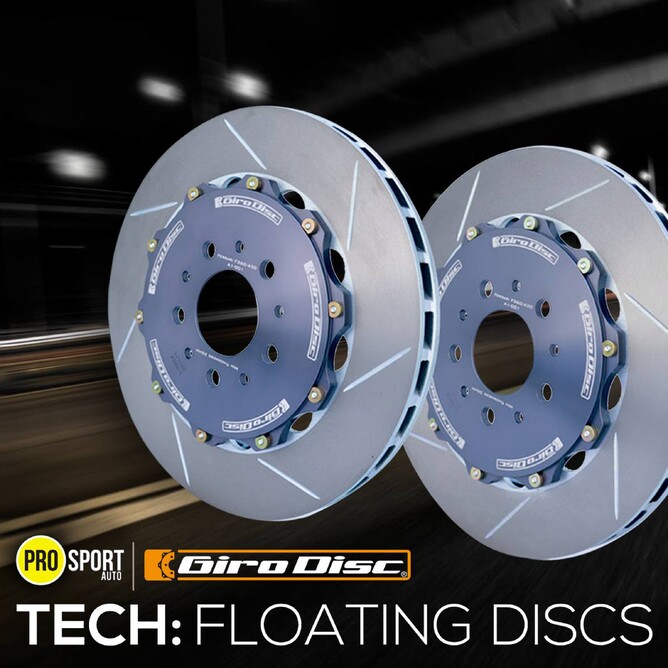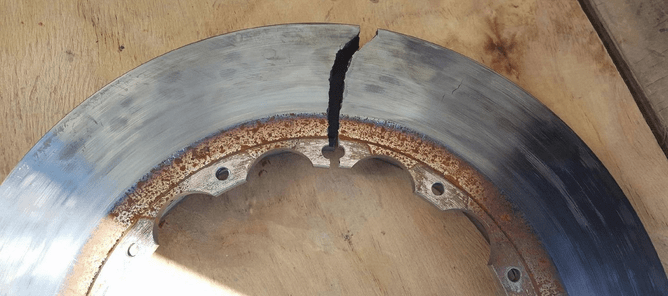Floating discs: What are they and why?
Even taken your car to the track and experienced a long or mushy brake pedal? Not only can this be caused by a fading brake pad, had you considered it could be caused by your discs?
When steel or iron is heated, it expands and the higher the heat value, the higher the expansion value. Single or two-piece fixed non-floating discs distort when heated, which causes them to 'cone'. This could be your problem...
When a disc cones, it means the outer diameter edge will curve outwards because only one side of the disc is attached to the 'hat', or the 'bell'.
When steel or iron is heated, it expands and the higher the heat value, the higher the expansion value. Single or two-piece fixed non-floating discs distort when heated, which causes them to 'cone'. This could be your problem...
When a disc cones, it means the outer diameter edge will curve outwards because only one side of the disc is attached to the 'hat', or the 'bell'.
Coning causes a large range of problems. Firstly, the pad to disc surface does not remain parallel, which means the pad surface is not flat on the disc. This results in a smaller contact surface area, which in turn amplifies the heat at that contact point, resulting in excess heat and brake failure. Another issue as a result of coning is it can push the outer pad pistons back into the caliper. This can cause a long or soft brake pedal, as part of the pedal stroke is to push the pad back onto the disc surface, rather than applying high pressure to generate friction to decelerate the vehicle.
Extreme scenario - Disc splits open
Why is a two-piece floating disc better?
Having a true two-piece floating disc allows the disc ring to expand with minimal stresses when it's heated. This keeps the disc surface flat relative to the pad surface (providing the hub/upright doesn't have flex). The result of switching over to a two-piece floating disc is a more consistent brake pedal feel and increased contact area between the disc and the pad. This means a longer service life of both your discs and your pads and increased braking performance.
With Girodisc products, floating is achieved with an oval slot on the disc. The hat (also known as a bell) has a circle hole to allow the bobbin to go through the hat and into the oval slot. It's then held together with a range of bolts and springs/clips. When the disc is cold, it's at its smallest diameter. When the disc is heated during braking, though, it will expand and it will slide along the bobbin.
To give you an indication of the extreme forces at play here, imagine trying to bend a 32mm-thick chunk of steel 1mm — this is what is happening when your non floating disc is "coning" during hot racing conditions. These forces are enough to crack discs and we've even seen some split entirely in two. A Steel/iron disc can expand up to around 2mm in total diameter at maximum temperatures — crazy right? The ultimate solution is a two-piece rotor if you're serious about your braking performance.
PSA tech tip: There are many ways to float a disc. For example: You can float on the hat (like ENDLESS), or float on the disc (like Girodisc). Our Strap-Drive system is still fully floating, but doesn't use either of these techniques.
With Girodisc products, floating is achieved with an oval slot on the disc. The hat (also known as a bell) has a circle hole to allow the bobbin to go through the hat and into the oval slot. It's then held together with a range of bolts and springs/clips. When the disc is cold, it's at its smallest diameter. When the disc is heated during braking, though, it will expand and it will slide along the bobbin.
To give you an indication of the extreme forces at play here, imagine trying to bend a 32mm-thick chunk of steel 1mm — this is what is happening when your non floating disc is "coning" during hot racing conditions. These forces are enough to crack discs and we've even seen some split entirely in two. A Steel/iron disc can expand up to around 2mm in total diameter at maximum temperatures — crazy right? The ultimate solution is a two-piece rotor if you're serious about your braking performance.
PSA tech tip: There are many ways to float a disc. For example: You can float on the hat (like ENDLESS), or float on the disc (like Girodisc). Our Strap-Drive system is still fully floating, but doesn't use either of these techniques.
There's more to learn about floating disc setups, keep your eyes peeled for next weeks blog in our continued series about floating disc setups. We'll be discussing the performance gains you can expect to see by switching from fixed/1-piece discs to 2-piece floating discs.



